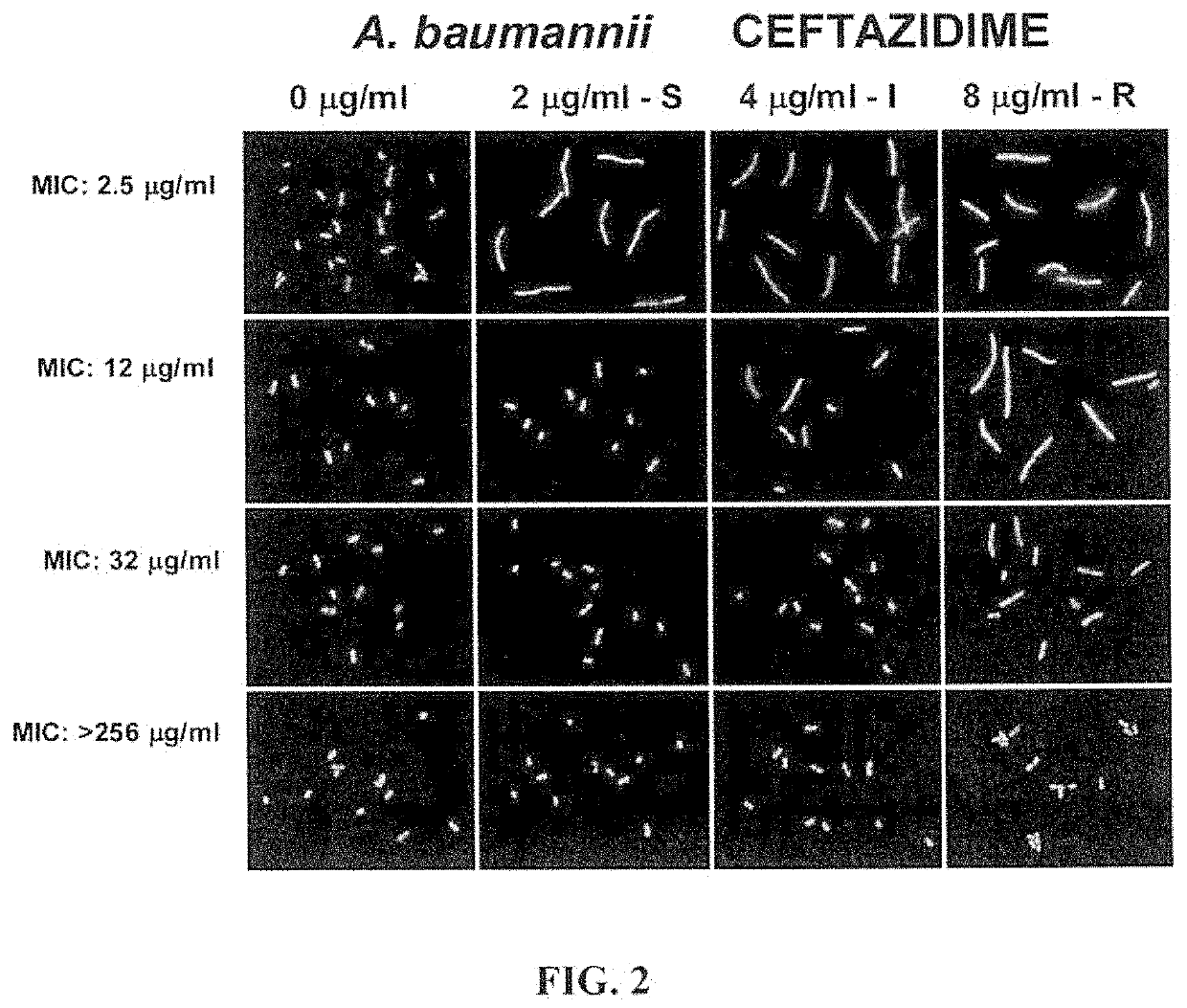Method for the rapid determination of susceptibility or resistance of bacteria to antibiotics
a technology of antibiotic susceptibility and rapid determination, applied in the field of biotechnology, can solve the problems of increasing resistance strains of bacteria, high mortality rate of infection, and difficulty in rapid determination of susceptibility or resistance of bacteria to antibiotics, and achieve the effect of rapid evaluation of susceptibility
- Summary
- Abstract
- Description
- Claims
- Application Information
AI Technical Summary
Benefits of technology
Problems solved by technology
Method used
Image
Examples
example 1
[0038]Concentrations of the cephalosporin antibiotic ceftazidime were correlated to the breakpoints for the classification of susceptible, intermediate and resistant strains of Acinetobacter baumannii according to the CLSI criteria. FIG. 2 shows images of various A. baumannii strains, including one susceptible strain, one intermediate strain and two strains resistant to the ceftazidime, according to the MIC-CLSI criteria. Several strains of A. baumannii, were incubated with ceftazidime for one hour, then enclosed in a microgel on a slide, dehydrated, stained with SYBR Gold and observed under fluorescence microscopy.
[0039]The first row of FIG. 2 illustrates images of a susceptible strain of A. baumannii, (having a MIC of 2.5 μg / ml) exposed to a control having no antibiotic, a second concentration of 2 μg / ml ceftazidime, a third concentration 4 μg / ml ceftazidime, and a fourth concentration of 8 μg / ml ceftazidime. The second row of FIG. 1 illustrates images of an intermediate strain of...
example 2
[0042]To validate the correlated breakpoint concentrations established in Example 1, 320 A. baumannii strains were processed. 51 of those strains were determined to be susceptible to ceftazidime according to MIC-CLSI established by an E-test, 35 strains were determined to be intermediate and 234 strains were determined to be resistant.
[0043]Each of the 320 strains of Acinetobacter baumannii were incubated with ceftazidime for an hour. Each dose was correlated to susceptibility breakpoints established in Example 1. The incubated samples were then assessed under microscopy for enlargement. The criterion of enlargement / non-enlargement was determined by a comparison to a control dose of 0 μg / ml. Strains were considered to be susceptible when they demonstrated enlargement in response to concentrations 2 μg / ml and up. Strains were considered to be intermediate when they demonstrated enlargement in response to concentrations 4 μg / ml and up. Strains were considered to be resistant when they...
example 3
[0044]Klebsiella pneumoniae, another significant pathogen in clinical settings, was also evaluated. According to the CLSI criteria a strain of K. pneumoniae is classified as susceptible to ceftazidime when the MIC≤4 μg / ml and resistant when MIC≥16 μg / ml. When using the bacterial length (enlargement), the new breakpoint concentrations for ceftazidime were empirically correlated in similar manner as described in Example 1, except that according to the MIC-CLSI standards an additional value for intermediate resistance was not determined. Those correlated breakpoint concentrations for enlargement were 0.5 μg / ml for susceptible strains and greater than 1.25 μg / ml for resistant strains. Stated differently, strains were considered to be susceptible when they demonstrated cell enlargement in response to concentrations of 0.5 μg / ml and 1.25 μg / ml and were considered to be intermediate when they demonstrated cell enlargement in response to only the 1.25 μg / ml dose. Strains were considered to ...
PUM
 Login to View More
Login to View More Abstract
Description
Claims
Application Information
 Login to View More
Login to View More - R&D
- Intellectual Property
- Life Sciences
- Materials
- Tech Scout
- Unparalleled Data Quality
- Higher Quality Content
- 60% Fewer Hallucinations
Browse by: Latest US Patents, China's latest patents, Technical Efficacy Thesaurus, Application Domain, Technology Topic, Popular Technical Reports.
© 2025 PatSnap. All rights reserved.Legal|Privacy policy|Modern Slavery Act Transparency Statement|Sitemap|About US| Contact US: help@patsnap.com


